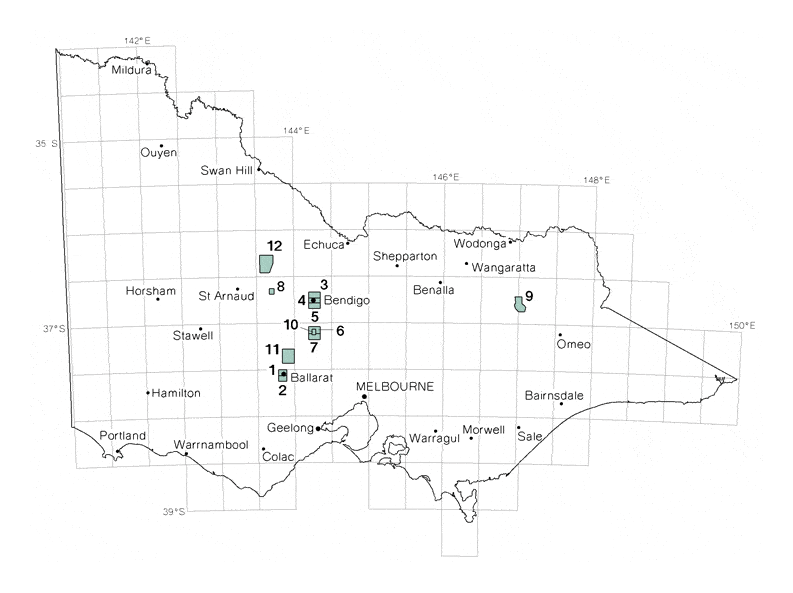History of gold mining in Victoria
Victoria is famous around the world for gold, and our history is closely linked to gold mining.
Gold was discovered at Ballarat in 1851, starting Victoria’s gold rush. Thousands of people came every week to try their luck.
Between 1852 and 1853, Ballarat was the richest goldfield in the world. Nearby Bendigo grew from a sheep farm into a busy town of 40,000 people in just one year.
People came from all over the world, bringing new skills, ideas, and cultures. The rush brought huge wealth, and Melbourne became known as “Marvellous Melbourne”, compared with great cities like Paris and London.
The gold rush changed Victoria forever, shaping the places we live in and the culture we share today.

How much gold has Victoria produced?
Victoria has produced more than 2,400 tonnes of gold. That’s about one-third of all the gold ever mined in Australia, and nearly 2 per cent of all the gold mined in the world.
For its size, Victoria has produced more gold than any other state in Australia — about 11 kilograms for every square kilometre.
Even today, these results match some of the best mines in Australia.
Over 180 years of gold discovery
1800
First Nations people had long known about gold, sometimes finding small, heavy nuggets in central Victoria’s creeks and rivers.
European settlers first came across gold in the 1840s. But they kept it quiet, as mining was illegal and gold belonged to the Crown.
Gold was found in Clunes in 1850. The discovery wasn’t officially announced until July 1851. By then, Victoria has become a separate colony and the British administration allowed mining of mineral resources.
Once word got out, the gold discovery near Clunes set off a rush. Soon, thousands of diggers were heading to Ballarat, Bendigo, Castlemaine and beyond.
People were awarded up to £1,000 for finding gold within 200 miles (320 kilometres) of Melbourne.
Victoria’s gold rush soon outshone the gold rush in New South Wales, producing more than one-third of the world’s gold in the 1850s.
1854 - Eureka Stockade
On 30 November 1854, miners from Ballarat, disgruntled with the colonial government's management of the goldfields, swore allegiance to the Southern Cross flag at Bakery Hill and built a stockade at the nearby Eureka diggings.
Early on the morning of Sunday 3 December, when the stockade was only lightly guarded, government troops attacked. At least 22 diggers, including one woman, and six soldiers were killed.
Eureka is a significant event in the development of Australia’s representational structures and attitudes towards democracy and egalitarianism.
1869 - Welcome Stranger
The Welcome Strange was the largest gold nugget ever found, is discovered on 5 February by Cornish miners John Deason and Richard Oates near Moliagul in central Victoria.
While searching around the roots of a tree they discovered, 3 cm below the surface, a gold nugget weighing 66kg, worth around $4 million based on today’s gold price.
- 1906 - There was a brief rush to Tarnagulla in central Victoria following the discovery of the Poseidon Nuggets with the largest being 953 oz (27 kilograms).
- 1920s - The Ballarat and Bendigo mines fell silent, and despite brief activity during the Great Depression, the gold mining industry lay dormant until the 1980s. Higher gold prices at that time saw a surge in prospecting and fossicking – largely using electronic detectors - as well as the return of full-scale mining operations to Stawell and Woods Point.
- 1972 - Annual total gold produced in Victoria for a single year dropped to 10kg - lowest level between 1851 and today.
- 1986 - The total annual production of gold in Victoria tops 1,000kg for the first time since 1959.
- 1990s - Gold mining activity in Victoria escalated sharply, with new mines opening and a significant increase in the level of expenditure on exploration. Information available through the Victorian Initiative for Minerals and Petroleum (VIMP) has acted as a catalyst for a rise in the number of applications for exploration licences in surveyed areas.
- 1995 - Construction of an ore processing plant at Costerfield signals the recommencement of mining activities near Heathcote. Productive gold mine continues to operate at site.
- 2005 - Commercial mining begins at Fosterville. The mine is the state’s largest producer today and is on schedule to be in Australia’s top five in 2019.
- 2011 - Underground gold mining and ore processing restarts at Ballarat.
- 2018 - Stawell Gold Mine announces return to production.
Historical images
View historical images of the gold rush era in Victoria:
Historical gold mining documentation
Browse these links for more information about the history of gold mining in Victoria:
Prospecting and fossicking
Looking for gems and minerals, such as gold, can be done using metal detectors or pans. To fossick in Victoria, you need a current fossicking permit known as a miner's right.
Find out about recreational fossicking and buying a miner's right.
Page last updated: 04 Sep 2025